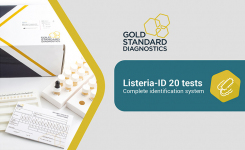ID Genomics (IDG) have announced the discovery of a nationwide rise in the levels of a drug-resistant ‘superbug’ - Escherichia coli strain ST1193.
“Our analysis is the first notification of E. coli ST1193’s pandemic rise in the last six years. We are witnessing a seven-fold increase in its prevalence since 2011 and a 35 percent jump in its spread in the past year in the USA alone,” said Evgeni Sokurenko, M.D., Ph.D., Founder of ID Genomics and Professor of Microbiology at the University Of Washington School Of Medicine.
Joining forces with the University of Washington, ID Genomics applied its proprietary technology, CLoNeT™, to quickly sort disease-causing bacteria into ‘crime families’ by identifying their genetic ‘fingerprints’ in a nationwide study. CLoNeT™ fingerprinting method detects when a ‘crime family’ of bacteria acquires new ‘weapons’ and expands their use. “These results show that sorting bacteria into ‘crime families’ with ‘criminal records’ has radical implications, which allow us to pinpoint the emergence and spread of new resistant bacteria,” said Dr. Sokurenko.
“Each year in the U.S. alone, more than a million people become infected with bacteria to which the prescribed antibiotic does not work, a trend that is only worsening over time,” said Kaveri Parker, Ph.D., President and CEO of IDG. “With our tools, we may be able to proactively predict where in the country newly emerging resistant bugs can be found, and help halt their spread.”
This 2-year ‘big-data’ analytics effort examined 11,000 bacterial strains isolated from patients with infections of blood, urinary, bladder, or kidneys at 9 medical centers in four different cities, from East to West coasts. Once the bacterial strains were fingerprinted by IDG’s technology, researchers determined the bugs’ responses to 10 different antibiotics, and linked all this information to geographical and historic data. By applying big-data tools, researchers discovered the rise of E. coli ST1193, 100% of which are resistant to the antibiotic Ciprofloxacin. Disturbingly, ST1193 already comprises up to a third of the total bacterial resistance to this commonly used drug. Ciprofloxacin is on the World Health Organization’s list of Essential Medicines, considered to be among the safest and most effective in addressing healthcare needs. The superbug is also mostly resistant to another popular antibiotic, Bactrim, as well as to tetracycline.
The study was presented this week at the Life Science Innovation Northwest conference in Seattle and showed that ST1193’s prevalence has increased dramatically in the last few years. In contrast, the proportion of other resistant strains in circulation has stayed the same or even dropped. Previously, there have been only sporadic and unconnected reports on isolation of E. coli ST1193 in China, Korea, Norway and the U.S.
While this study focused on E. coli that cause blood and urinary tract infections, it shows that IDG’s methods may check the rise of superbugs across other types of infections. This discovery has tremendous implications in today’s healthcare landscape, in which routine clinical decisions are complicated by rising antibiotic resistance.
“Surveillance efforts like these are critical to recognizing the emergence of new superbugs and finding ways to stop their spread before they become pandemics,” said Dr. Lance Price of George Washington University’s Antibiotic Resistance Action Center in Washington, D.C. “One of the best ways to slow the spread of superbugs is to use antibiotics more carefully. Smart surveillance approaches, such as the one used here, can help guide better selection of antibiotics and reduce the fuel that drives the success of superbugs like ST1193.”
Studies like this one enable scientists to identify whether a known bacterium is causing higher rates of disease across the U.S., or if a new bacterial ‘crime family’ is acquiring more resistance. “Today, scientists can readily access a gigantic amount of data. The challenge is to reduce all that complexity and leverage it into discoveries that benefit society. We are humbled to lead the wave of biotechnology that never loses sight of its patients,” said Dr. Sokurenko.
ID Genomics plans to continue developing its diagnostic platform through the Food and Drug Administration’s 510(k) regulatory pathway, and eventually build a microbial surveillance network capable of monitoring infectious bacteria globally. The Company recently received a Discovery Award from the Longitude Prize, and is funded by a $3,000,000 NIH STTR grant.























